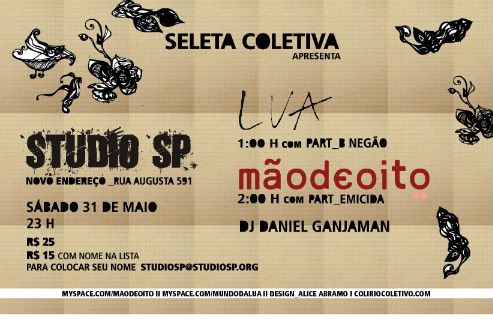
Rota do acarajé
On Wednesday I was initiated into the cult of Bahian cuisine at Rota do Acarajé, a restaurant in the neighborhood of Santa Cecília. Since I arrived in Brazil, comida baiana has been described to me as spicy, heavy, delicious, African-influenced, flavorful, greasy, and strange. I have only one word to describe it: delicious.
Rota do Acarajé (recommended by the evening's convener, M.) reminded me of some soul food restaurants in Harlem. Eclectically decorated with mismatched chairs and vintage Bahia memorabilia, it was easy to get comfortable, especially when the ice cold Bohemia started flowing. I took a look at the menu and quickly realized there were more words I didn't know than words I did. I deferred to my Brazilian friends who selected an appetizer of acarajé, and two main dishes, moqueca de cação e camarão and escondidinho de carne seca.

Acarajé (featured to the right with all its fixins') is one of Bahia's signature dishes. It's kind of like a bready hush puppy fried in azeite de dende, the bright orange palm oil applied generously to all Bahian cooking. For me, the best part of the acarajé were its accoutrements: camarão (little dried shrimp), caruru (sauteed okra, ground nuts, and onions ), and, my favorite, vatapá (a mush of ground shrimp, manioc flour, and cashews). I also helped myself to the pimenta, a salsa made from the devilish malegueta chile, which challenged even my chile-raised, New Mexican palette.
The main dishes were served family style and one order of each was enough to feed all six of us. Escondidinho (direct translation would be little tiny hidden one, I think) was a bit like a shepherd's pie, except the meat was shredded dried beef (typical of the hot Northeast region) and the topping was mashed aipim (manioc). I liked the escondidinho, but the moqueca, a seafood stew made with coconut milk, vegetables, garlic, cilantro, and tomato, won my heart. The cação (shark) was unbelievably tender and gently perfumed by the coconut milk and herbs. There were a was a tasty side dish, like a manioc polenta, called pirão, and fluffy white rice to soak up the moqueca.

Bahian food was nurtured into being by the West Africans forced to Brazil as slaves over 300 years ago, who incorporated both New World ingredients and Portuguese and Indian preparations into their traditional cuisine. Today, Bahian cuisine is the most distinctive and reputed in Brazil. Compared to the traditional Brazilian fare I've sampled in São Paulo--lots of beans, rice, manioc, beef and pork, and flavored mostly with garlic, parsley, lime, and salt--this meal was downright revolutionary. So many different spices and textures! Add to that lively conversation with new friends (in Portuguese, no less), and a table-side samba trio (trombone, bass drum, and snare) and I was one happy girl. And let's not forget the sobremesa of homemade tapioca ice cream flavored with honey and specked with fresh coconut. Adorei!
 After weeks of absorbing Brazilian rhythms, I finally got my chance at creating some of my own at Prego Batido percussion school. On the recommendation of a friend, I enrolled in a three-day intensive class to learn basic samba rhythms and instrumentation. I barely scratched the surface, but I had one hell of a time.
After weeks of absorbing Brazilian rhythms, I finally got my chance at creating some of my own at Prego Batido percussion school. On the recommendation of a friend, I enrolled in a three-day intensive class to learn basic samba rhythms and instrumentation. I barely scratched the surface, but I had one hell of a time. 

















